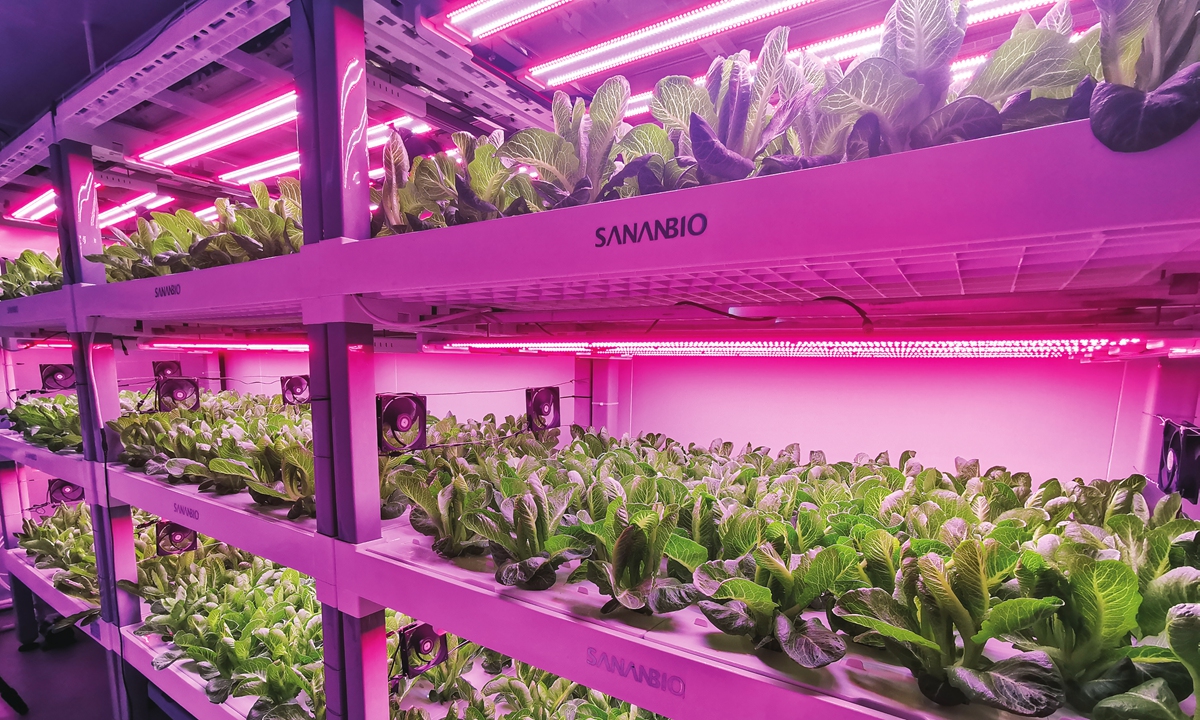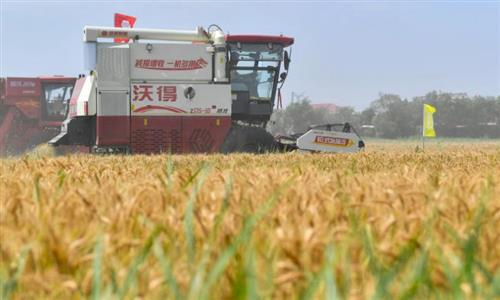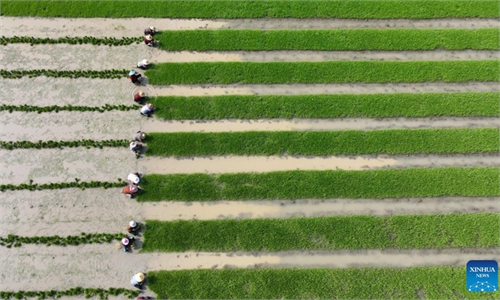Vertical farming points to future agriculture, set to inject impetus to China’s food security drive: expert

Crops growing in a vertical farm factory Photo: Courtesy of the Shanghai Academy of Agricultural Sciences
Inside several containers located in a vertical farming research center in Shanghai, crops are growing rapidly. Without natural sunlight and soil, they are grown in an indoor space - a micro greenhouse measuring no more than 20 square meters.
This evolution in modern agriculture may be shocking to some. However, behind the scenes, talent drawn from multiple disciplines such as agriculture and computing are continuously making headways.
In a recently concluded vertical farming competition held in Shanghai, a team from the Shanghai Academy of Agricultural Sciences won the first prize thanks to lettuce grown in a container that stood out from among all four competitors in the final round in terms of output.
Team leader He Lizhong told the Global Times on Tuesday that "we have previous experience in growing hydroponic greens in the greenhouse, and the nutrient solution recipe - which plays the role of soil in field planting - is also significant for the quality of lettuce."
By adopting technologies such as artificial intelligence, LED lighting, and a concise nutrient model, the lettuce seedling in the container is able to access elements necessary for its growth including temperature, lighting, air and water, He noted.
Prospective farming
The container in the above-mentioned scenario is like a plant factory, which refers to a closed growth system that enables a cultivator to achieve constant vegetable production all year around.
The factory could be established anywhere, from the desert to the plateau, and even in city skyscrapers, or even outside the Earth, as it could serve as an important means to achieve food self-supply during space exploration for astronauts.
In the plant factory, there are usually vertically-stacked plants in a fully controlled environment.
The cutting-edge technology is believed to have the potential to meet the rising population's demand for food without the need for additional farmland.
As the global population continues to grow, and with the number of people in the world more than doubled between 1961 and 2016, there is greater demand for food. The strain on land, which is a limited resource, has also grown. Global cropland area per capita decreased continuously over the period between 1961 and 2016: From about 0.45 hectare per capita in 1961 to 0.21 hectare per capita in 2016, according to a report by the Food and Agriculture Organization of the United Nations.
Given the prospective future of vertical farming, experts and industry players said it will not only play an effective role in supplementing residents' food needs in the future, but also be a significant driver for the development of intelligent and modern agriculture.
Wei Lingling, CEO of AgriGarden Protected Horticulture Technology, one of the pioneers in China to use vertical farming, told the Global Times on Wednesday that in addition to vegetables, the company's vertical farming factory has also experimented with grain crops such as rice.
"The dwarfed rice in our seven-layer plant factory absorbs both natural light and LED light, and the yield could reach five to six generations within a year compared with one to two generations by using traditional cultivation methods," Wei said.
"If the technology could be promoted in large scale, it could inject impetus to the nation's food security drive," she noted, adding that the company is also exploring applications of the technology on dwarfed wheat and corn.
Currently, an enormous investment need in vertical farming factory is putting curbs on the technology's commercialization in the mass market.
Power consumption accounts for about 52 percent of the entire cost of a plant factory , of which 60 percent comes from light sources, while the remainder comes from air conditioning, Yang Qichang, deputy director of the Chinese Academy of Agricultural Sciences' Institute of Urban Agriculture, told the Global Times on Tuesday.
Although Wei's plant factory has not turned profitable yet due to high production costs, she believes this move holds the key to future smart agriculture: That is, to solve the food supply problem by adopting more cutting-edge technologies to have more yields within a limited space.
For domestic players in the sector, competition is not fierce at the moment as it is still a niche market. "With more policy support in place, I think market demand will be boosted, thus driving the sector's future development," Wei said.
In urban areas where more people are expected to flow into, vertical farming could have more space to flourish. For instance, its embedding in commercial scenarios like office buildings or shopping malls has become trendy, she noted.
Taking the lead
During Chinese Premier Li Qiang's visit to Germany in June, he witnessed technology and product demonstrations such as indoor vertical farming, the digital enterprise experience center, automatic sorting robots, and high-end magnetic resonance equipment at the Siemens headquarters.
Despite China being latecomer to the exploration of vertical farming in the early 2000s compared with Europe and Japan, it is widely recognized as a leading force in terms of technology.
China has accumulated obvious advantages in the five major technologies in the sector - lighting, nutrient solution systems, environmental monitoring and systems control, intelligent equipment like robots, and intelligent decision-making based on AI computing and modeling, Yang noted.
He took the LED lighting as an example. In order to make the plant factory more feasible financially, Chinese scientists have made unremitting efforts, and now comprehensive energy consumption has been brought down to 8.25 kilowatt per kilogram of vegetables from the initial 31-42 kilowatts per kilogram.
"The current international level is around 10, so our technological breakthrough provides a good support for the large-scale application of plant factories in the future," Yang said.
"Theoretically, we calculated that it now can be reduced to 4-5 kilowatts per kilogram," he added.
China could now export its technology in the sector to other countries as vertical farming has become a global practice.
Singapore, for example, has high demand for vertical farming due to its dense population and limited land. The city state imports more than 90 percent of its food.



